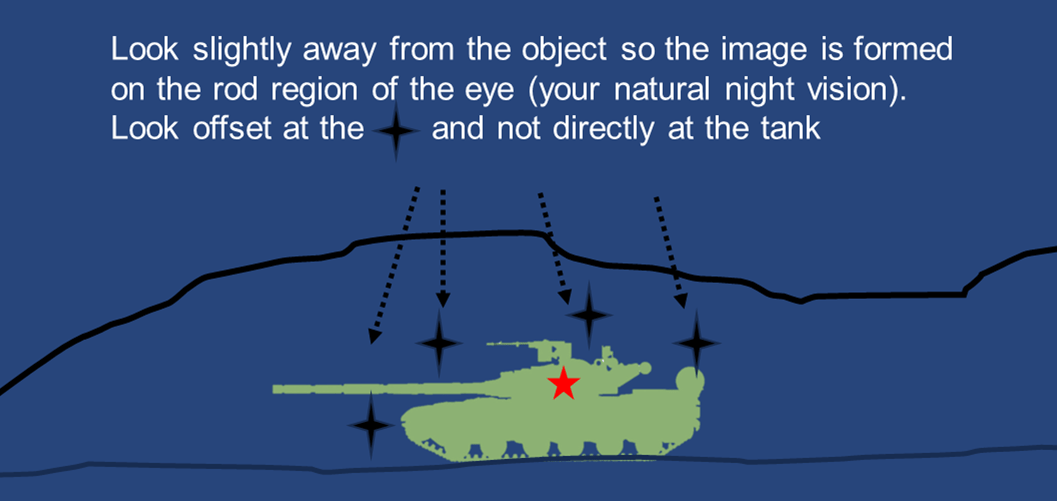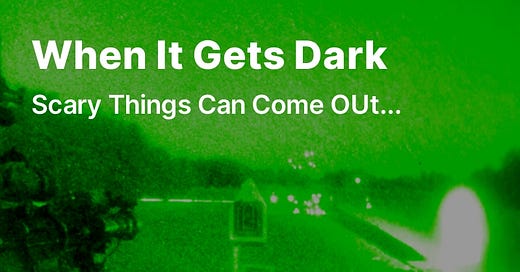This article was written by Jack Morris from The Professional Citizen Project as part of their weekly newsletter series. If you are not subscribed to it, please visit the link below.
The Professional Citizen Project Newsletter
When It Gets Dark
There are countless lighting conditions and combinations that are present in an environment, but they fall into two distinct large categories. There are multiple definitions of ambient light, for the ease of our discussion we will roll ambient into one large chunk. Each will have its own challenges for a unit working in the dark. The “so what?” of this is it allows you to plan and adjust your techniques and tools you will use for the situation. If there is a significant amount of ambient light (for example the typical neighborhood streetlights) you may choose to a monocular so you can read and use shadows more easily or even opt to have some team members go without NV altogether. There are no canned solutions, it is a thinking man’s game. Understanding environmental variables and knowing how to adjust to them is critical; this is especially true at night.
Ambient (either natural or artificial) light. Ambient light is existing light we did not bring to the environment. Also known as available light, it is any light source that you haven’t set up or activated yourself. This includes natural light or pre-existing lighting built in and around a location, a structure or street. Examples are sunlight, moonlight, streetlamps, facility floodlights, or even the existing artificial lighting that is on inside a building.
Directed artificial light (Active). Searchlights, spotlights, flashlights, or headlights on a vehicle are all examples of this. Weapon mounted lights and handheld flashlights are in this category as well. Visible directed artificial light in any form (any color or spectrum) is always active; we must assume it can always be detected by an opponent. IR lights are also included in the active category - and we must always assume any threat to have a passive NV capability.

Natural Night Vision. We must be aware of the constraints your eyes place upon you at night. Roughly 80 percent of your sensory input comes through vision, learning how to work around the negative effects of darkness takes time and training. Natural human night vision peaks in the mid teen years and gets progressively diminished as we age (yay youth). But understanding some of the techniques and how to mitigate the biological limitations can still give you an edge - even if you are in the Dollar Tree reading glasses age bracket.
Some of these constraints we must understand:
Your ability to see crisp and clear images (your visual acuity) is reduced and under certain conditions, you cannot distinguish one color from another.
Your depth perception is reduced (and no, dual tube NV does not increase the user’s depth perception).
You have "night blind spot," which makes it difficult to see objects at certain distances.
Lights cause the loss of dark adaptation. This includes red lens flashlights, the screens of thermal or NV systems, and of course white light.
Your eyes may seem to play tricks on you, just like when we were kids you will start to see things as the reduced visual acuity combines with the human psyche especially when we are sleep deprived. Shapes can appear to move or be something they are not.
You will also have slower reaction times because of the reduced lighting levels.
Normal Blind Spots. The "normal blind spot" is always present, day and night. It is caused by the lack of light receptors where the optic nerve inserts into the back of the eye. The "normal blind spot" occurs when you use just one eye. When you close the other eye, objects about 12 to 15 degrees away from where you are looking will disappear. When you uncover your eye, the objects will reappear.
Night Blind Spots and Viewing Techniques. When you stare at an object at night with the naked eye under low levels of illumination, it can seem to disappear or fade away. This is a result of the night blind spot. It affects both eyes at the same time and occurs when using the central vision of both eyes. Consequently, even large objects are missed as the distances increase. If you are looking directly at something at night, you may miss it because of the night blind spot.
In order to avoid this night blind spot with the unaided eye, look to all sides of objects you are trying to find or follow. This is referred to as off center vision. Do not stare. It is an individual training component to learn not to stare or strain when your attention is on an object at night. This is the only way to maximize your unaided night vision.

A good technique for peripheral viewing is called "diamond viewing." Diamond viewing means that you move your eyes just slightly, a few degrees, in a diamond pattern around the object you wish to see. You do not have to move your head-use your peripheral vision, just slight eye movement off the target will do the job.

It is important for us to spend time outside in the dark wilderness without using your NV system. Darkness not only makes objects difficult to see but also changes their appearance, distorts size, and blots out details. A tree visible against the night sky appears smaller than in the daytime because the twigs at the end of branches cannot be seen. You must train to identify objects by block outlines at night and cannot rely on details visible in daylight. Binoculars are helpful at night (at times) to enlarge objects or parts of objects otherwise too small to be seen and help identify objects already spotted. Night observation devices should be used when the situation requires (odds are this will be most times). Night vision devices are mandatory, a PVS14 is as critical as a firearm and should be prioritized in your budget. But there are some old school techniques that can help when you don’t have or don’t want to use your NV system.
The Professional Citizen Project also has a series of field manuals designed and written for the everyday civilian to gain a working understanding of everything from tactically oriented skills, fieldcraft, survival, manual of arms, Minuteman philosophy, prepping/preparedness, and more. They also offer various bits of gear to help aid in your outdoor endeavors here.
The Professional Citizen Project manuals include:




Are you really prepared if you can’t see in the dark? Too much low light equipment on the market to not have some. They’re available from just under $300 to way over a thousand!